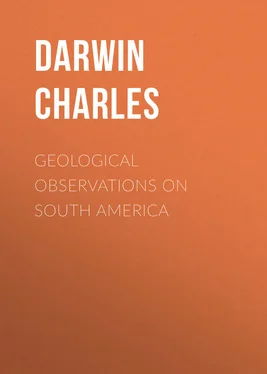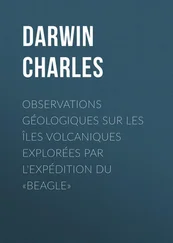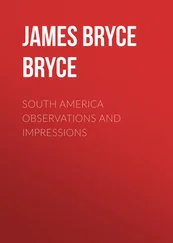Charles Darwin - Geological Observations on South America
Здесь есть возможность читать онлайн «Charles Darwin - Geological Observations on South America» — ознакомительный отрывок электронной книги совершенно бесплатно, а после прочтения отрывка купить полную версию. В некоторых случаях можно слушать аудио, скачать через торрент в формате fb2 и присутствует краткое содержание. Жанр: foreign_antique, foreign_prose, на английском языке. Описание произведения, (предисловие) а так же отзывы посетителей доступны на портале библиотеки ЛибКат.
- Название:Geological Observations on South America
- Автор:
- Жанр:
- Год:неизвестен
- ISBN:нет данных
- Рейтинг книги:3 / 5. Голосов: 1
-
Избранное:Добавить в избранное
- Отзывы:
-
Ваша оценка:
- 60
- 1
- 2
- 3
- 4
- 5
Geological Observations on South America: краткое содержание, описание и аннотация
Предлагаем к чтению аннотацию, описание, краткое содержание или предисловие (зависит от того, что написал сам автор книги «Geological Observations on South America»). Если вы не нашли необходимую информацию о книге — напишите в комментариях, мы постараемся отыскать её.
Geological Observations on South America — читать онлайн ознакомительный отрывок
Ниже представлен текст книги, разбитый по страницам. Система сохранения места последней прочитанной страницы, позволяет с удобством читать онлайн бесплатно книгу «Geological Observations on South America», без необходимости каждый раз заново искать на чём Вы остановились. Поставьте закладку, и сможете в любой момент перейти на страницу, на которой закончили чтение.
Интервал:
Закладка:
At one of the highest parts of the cliff, estimated 120 feet above the sea, where a little ravine came down, there were two sections, at right angles to each other, of the floor of a shed or building. In both sections or faces, two rows, one over the other, of large round stones could be distinctly seen; they were packed close together on an artificial layer of sand two inches thick, which had been placed on the natural clay-beds; the round stones were covered by three feet in thickness of the loam with broken sea-shells and pottery. Hence, before this widely spread-out bed of loam was deposited, it is certain that the plain was inhabited; and it is probable, from the broken vessels being so much more abundant in certain spots than in others, and from the underlying clay being fitted for their manufacture, that the kilns stood here.
The smoothness and wide extent of the plain, the bulk of matter deposited, and the obscure traces of stratification seem to indicate that the loam was deposited under water; on the other hand, the presence of sea-shells, their broken state, the pebbles of various sizes, and the artificial floor of round stones, almost prove that it must have originated in a rush of water from the sea over the land. The height of the plain, namely, 120 feet, renders it improbable that an earthquake-wave, vast as some have here been, could have broken over the surface at its present level; but when the land stood eighty-five feet lower, at the period when the shells were thrown up on the ledge at S. Lorenzo, and when as we know man inhabited this district, such an event might well have occurred; and if we may further suppose, that the plain was at that time converted into a temporary lake, as actually occurred, during the earthquakes of 1713 and 1746, in the case of the low land round Callao owing to its being encircled by a high shingle-beach, all the appearances above described will be perfectly explained. I must add, that at a lower level near the point where the present low land round Callao joins the higher plain, there are appearances of two distinct deposits both apparently formed by debacles: in the upper one, a horse's tooth and a dog's jaw were embedded; so that both must have been formed after the settlement of the Spaniards: according to Acosta, the earthquake-wave of 1586 rose eighty-four feet.
The inhabitants of Callao do not believe, as far as I could ascertain, that any change in level is now in progress. The great fragments of brickwork, which it is asserted can be seen at the bottom of the sea, and which have been adduced as a proof of a late subsidence, are, as I am informed by Mr. Gill, a resident engineer, loose fragments; this is probable, for I found on the beach, and not near the remains of any building, masses of brickwork, three and four feet square, which had been washed into their present places, and smoothed over with shingle during the earthquake of 1746. The spit of land, on which the ruins of OLD Callao stand, is so extremely low and narrow, that it is improbable in the highest degree that a town should have been founded on it in its present state; and I have lately heard that M. Tschudi has come to the conclusion, from a comparison of old with modern charts, that the coast both south and north of Callao has subsided. (I am indebted for this fact to Dr. E. Dieffenbach. I may add that there is a tradition, that the islands of San Lorenzo and Fronton were once joined, and that the channel between San Lorenzo and the mainland, now above two miles in width, was so narrow that cattle used to swim over.) I have shown that the island of San Lorenzo has been upraised eighty-five feet since the Peruvians inhabited this country; and whatever may have been the amount of recent subsidence, by so much more must the elevation have exceeded the eighty-five feet. In several places in this neighbourhood, marks of sea-action have been observed: Ulloa gives a detailed account of such appearances at a point five leagues northward of Callao: Mr. Cruikshank found near Lima successive lines of sea-cliffs, with rounded blocks at their bases, at a height of 700 feet above the present level of the sea. ("Observaciones sobre el Clima del Lima" par Dr. H. Unanue page 4. – Ulloa's "Voyage" volume 2 English Translation page 97. – For Mr. Cruikshank's observations, see Mr. Lyell's "Principles of Geology" 1st edition volume 3 page 130.) ON THE DECAY OF UPRAISED SEA-SHELLS.
I have stated that many of the shells on the lower inclined ledge or terrace of San Lorenzo are corroded in a peculiar manner, and that they have a much more ancient appearance than the same species at considerably greater heights on the coast of Chile. I have, also, stated that these shells in the upper part of the ledge, at the height of eighty-five feet above the sea, are falling, and in some parts are quite changed into a fine, soft, saline, calcareous powder. The finest part of this powder has been analysed for me, at the request of Sir H. De la Beche, by the kindness of Mr. Trenham Reeks of the Museum of Economic Geology; it consists of carbonate of lime in abundance, of sulphate and muriate of lime, and of muriate and sulphate of soda. The carbonate of lime is obviously derived from the shells; and common salt is so abundant in parts of the bed, that, as before remarked, the univalves are often filled with it. The sulphate of lime may have been derived, as has probably the common salt, from the evaporation of the sea-spray, during the emergence of the land; for sulphate of lime is now copiously deposited from the spray on the shores of Ascension. (See "Volcanic Islands" etc. by the Author.) The other saline bodies may perhaps have been partially thus derived, but chiefly, as I conclude from the following facts, through a different means.
On most parts of the second ledge or old sea-beach, at a height of 170 feet, there is a layer of white powder of variable thickness, as much in some parts as two inches, lying on the angular, salt-cemented fragments of sandstone and under about four inches of earth, which powder, from its close resemblance in nature to the upper and most decayed parts of the shelly mass, I can hardly doubt originally existed as a bed of shells, now much collapsed and quite disintegrated. I could not discover with the microscope a trace of organic structure in it; but its chemical constituents, according to Mr. Reeks, are the same as in the powder extracted from amongst the decaying shells on the lower ledge, with the marked exception that the carbonate of lime is present in only very small quantity. On the third and highest ledge, I observed some of this powder in a similar position, and likewise occasionally in small patches at considerably greater heights near the summit of the island. At Iquique, where the whole face of the country is covered by a highly saliferous alluvium, and where the climate is extremely dry, we have seen that, according to Mr. Blake, the shells which are perfect near the beach become, in ascending, gradually less and less perfect, until scarcely a trace of their original structure can be discovered. It is known that carbonate of lime and common salt left in a mass together, and slightly moistened, partially decompose each other (I am informed by Dr. Kane, through Mr. Reeks, that a manufactory was established on this principle in France, but failed from the small quantity of carbonate of soda produced. Sprengel "Gardeners' Chronicle" 1845 page 157, states, that salt and carbonate of lime are liable to mutual decomposition in the soil. Sir H. De la Beche informs me, that calcareous rocks washed by the spray of the sea, are often corroded in a peculiar manner; see also on this latter subject "Gardeners' Chronicle" page 675 1844.): now we have at San Lorenzo and at Iquique, in the shells and salt packed together, and occasionally moistened by the so- called Peruvian dew, the proper elements for this action. We can thus understand the peculiar corroded appearance of the shells on San Lorenzo, and the great decrease of quantity in the carbonate of lime in the powder on the upper ledge. There is, however, a great difficulty on this view, for the resultant salts should be carbonate of soda and muriate of lime; the latter is present, but not the carbonate of soda. Hence I am led to the perhaps unauthorised conjecture (which I shall hereafter have to refer to) that the carbonate of soda, by some unexplained means, becomes converted into a sulphate.
Читать дальшеИнтервал:
Закладка:
Похожие книги на «Geological Observations on South America»
Представляем Вашему вниманию похожие книги на «Geological Observations on South America» списком для выбора. Мы отобрали схожую по названию и смыслу литературу в надежде предоставить читателям больше вариантов отыскать новые, интересные, ещё непрочитанные произведения.
Обсуждение, отзывы о книге «Geological Observations on South America» и просто собственные мнения читателей. Оставьте ваши комментарии, напишите, что Вы думаете о произведении, его смысле или главных героях. Укажите что конкретно понравилось, а что нет, и почему Вы так считаете.












